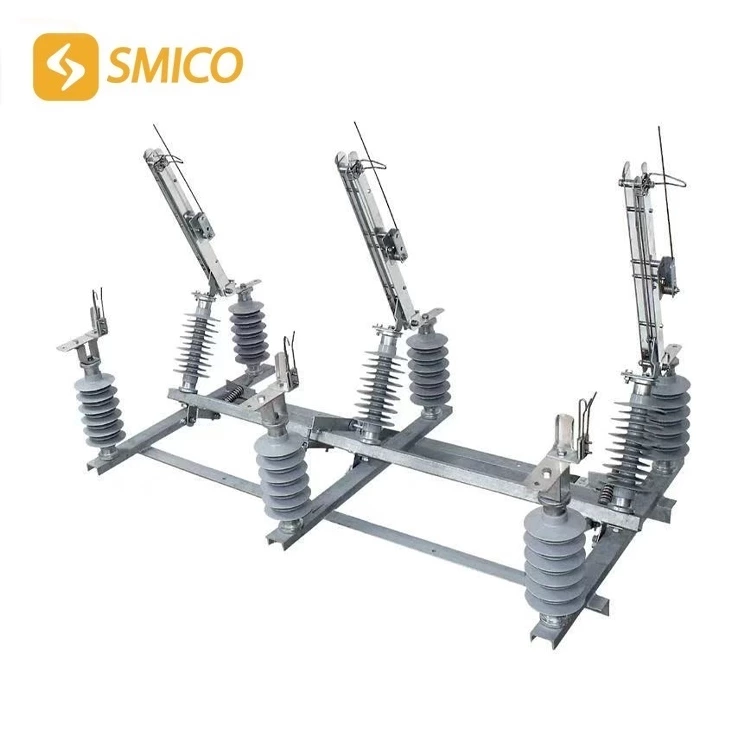Abnormal Accident Of High Voltage Isolating Switch
1. The high voltage isolator switch part of the bus side is heated.
When inspecting the equipment, the hv isolator switch contact part can be judged by the hot air flow, heat or discoloration of the contact part, and whether the temperature of the contact part exceeds 70℃. The cause of the heat is usually the loosening of the compressed spring studs and surface oxidation. Treat them according to different wiring methods.
① In the case of double busbar wiring: If the bus side hv isolator is heated, the circuit should be reversed to another set of busbars, and then the heated high voltage electrical isolator should be pulled out.
When repairing the heated isolator high voltage, the bus should be powered off, and the circuit breaker of its circuit should also be powered off. The bypass circuit breaker can be used to operate it. If there is no bypass circuit breaker, the circuit should be powered off.
② In the case of single busbar wiring: If the isolating switch on the bus side is heated, the dispatcher should be reported to request load reduction. If there is a bypass circuit breaker, it should be used to operate it. If there is no bypass circuit breaker, it is best to shut down the line. If the load cannot be shut down and the load cannot be reduced due to load reasons, monitoring must be strengthened. When the heat reaches a relatively serious degree, the circuit breaker should be pulled open for accident handling.
When repairing the hot isolating switch, the busbar should be shut down, that is, all circuits on the busbar should be shut down, or the busbar should not be shut down, and the live operation method should be adopted.
2. The line isolating switch is hot
Its treatment method is the same as that of the single busbar isolating switch. The difference is that the isolating switch has a circuit breaker in series, which can prevent the development of accidents. Therefore, the isolating switch can continue to operate, but it needs to be monitored until it can be shut down for maintenance.
When repairing the isolating switch, its line should be shut down.
3. The porcelain bottle of the isolating switch is cracked or damaged
If the porcelain bottle of the isolating switch is cracked or damaged to a lesser extent, it can continue to operate, but when there is discharge or the degree of damage is serious, it should be shut down. Note: When operating the disconnector, do not pull it open with power on to prevent the porcelain bottle from breaking during operation and causing bus or line failure. For example, if the porcelain bottle of the bus side disconnector of its circuit is seriously damaged, the bus where it is located should be powered off, the circuit breaker of the circuit and the disconnector on the line side should be disconnected, and finally the disconnector should be pulled open.
4. The disconnector refuses to pull or close
When the disconnector refuses to pull or close, blind and forced operation should be prohibited, and the cause should be analyzed. Different treatment methods should be adopted for different fault causes.
① If the anti-error device (electromagnetic lock, mechanical lock, electrical circuit lock, program lock) fails, the operator should check whether the operation procedure is correct. If the procedure is correct, the operation should be stopped immediately and reported to the substation manager. It should be determined that the anti-error device has failed before the lock can be released for operation, or it can be handled as a defect and handled normally by the maintenance personnel before operation can be carried out.
② If the knife of the electric operating mechanism cannot be opened or closed, a multimeter should be used to measure whether the motor power supply has power. If the power supply is normal and the contactor is normal, it may be a motor failure. The motor power supply needs to be pulled open and changed to manual operation.
③ If the disconnector cannot be operated due to a mechanical failure of the transmission mechanism in the province, the dispatcher should be notified and the faulty disconnector should be transferred to maintenance for maintenance personnel to handle.
④ If the disconnector cannot be operated normally due to freezing or equipment corrosion, it should not be operated with a large impact force, but with a smaller driving force to shake back and forth to overcome the abnormal resistance.
⑤ When it is found that the contact part between the blade and the blade mouth of the disconnector is in conflict during operation, it should not be operated forcibly, otherwise it may cause damage to the supporting porcelain bottle and cause an accident. The disconnector should be powered off immediately.

